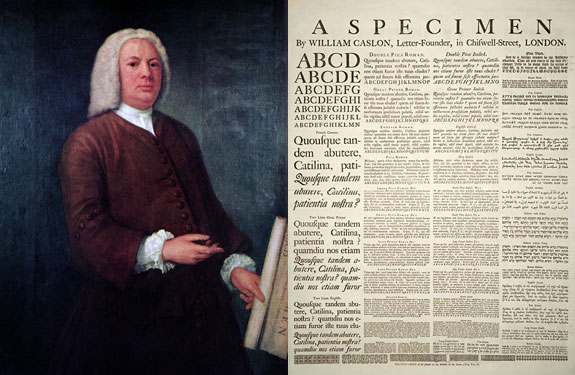January 23

“Mr. Caslon is an Artist, to whom the Republic of Learning has great obligations; his ingenuity has left a fairer copy for my emulation, than any other master.” So wrote John Baskerville about the most famous of all English typefounders, William Caslon, who died January 23, 1766.
It is curious various accounts of how Caslon became a typefounder are in disagreement. Talbot Baines Reed mentions the conflicting stories in his History of the Old English Letter Foundries, published in 1887. The typefounder, born in 1692, became apprenticed to an engraver of gun-locks and barrels in London. In addition Caslon did silver-chasing and upon occasion designed tools for bookbinding. Some punches which he prepared for a bookbinder attracted the attention of a famous printer of London, John Watts, who has had some subsequent reputation as the employer of Benjamin Franklin when the American printer worked in London in 1725.
Watts, encouraging Caslon to continue his studies in letter-cutting, introduced him to other London printers. About the same time, another well-known printer, William Bowyer the elder, also saw some lettering on the binding of a book designed by Caslon. Seeking out the young man, Bowyer took him to visit the typefoundry operated by Thomas James in Bartholomew Close. Bowyer then asked him whether he could cut types. As he had never been to a typefoundry before, Caslon requested one day to think about the matter. Later he agreed to set up his own foundry with loans from Bowyer, John Watts, and another printer named Bettenham.
Thus established, Caslon quickly justified the faith of his printer friends. After a short period of dependence upon their custom, he was on his own. The foundry he began about 1720 is still in existence under the name of Stephenson Blake, the Caslon Letter Foundry. The reliance of English printers upon Dutch sources was thus halted. Caslon began a school of English type design which continued through the work of Baskerville, Martin, Austin, and the 19th century founders.
In 1734 Caslon published his famous broadside specimen sheet, showing his great roman with its fine italic, an excellent English blackletter, and a number of “exotic” letters such as Coptic, Armenian, Hebrew, Greek, etc. A copy of this specimen was bound into the second edition of Chambers’s Cyclopaedia in 1738, with the notice: “The above were all cast in the foundry of Mr. W. Caslon, a person who, though not bred to the art of letter-founding, has by dint of genius, arrived at an excellency in it unknown hitherto in England, and which even surpasses anything of the kind done in Holland or elsewhere.”
D.B. Updike has attempted in his Printing Types to explain the popularity of the Caslon types. Except for a short period from about 1800 to the 1840’s, these types have never been out of fashion: “Why are William Caslon’s types so excellent and so famous? To explain this and make it really clear, is difficult. While he modelled his letters on Dutch types, they were much better; for he introduced into his fonts a quality of interest, a variety of design, and a delicacy of modelling which few Dutch types possessed.
. . . His letters, when analyzed, especially in the smaller sizes, are not perfect individually; but in mass their effect is agreeable. That is, I think, their secret—a perfection of the whole, derived from harmonious but not necessarily perfect individual letterforms!”